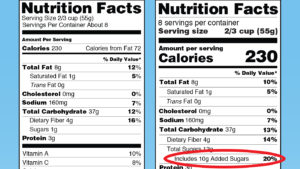
Guide to New Food Labels and Added Sugars
12/12/2017
Is the sugar that makes your fruit sweet the same as the sugar in cookies? Well, yes… and no. While both are sugar, there is a difference. That’s why the FDA is making a change to the nutrition labels on food packaging.
After 20 years of the nutrition label remaining the same, the new FDA label will have a separate line to show how much sugar has been added to each food.
According to Dr. Fadi Aramouni, professor of food science at Kansas State University, manufacturers have until Jan. 1. 2020, to comply with the new labeling requirements. Manufacturers with less than $10 million in annual food sales will have an additional year. The new label means there will be more information available. Dr. Aramouni outlined the differences shoppers will see:
- Easier to read information on food packages: increased type size for ‘calories,’ ‘servings per container’ and the ‘serving size’ declaration, and bold type for number of calories and the ‘serving size’ declaration.
- More information about certain nutrients which were not mandatory before: vitamin D, potassium and added sugars.
- Updated serving sizes for certain products: e.g. the reference amount for a serving of ice cream was previously one-half cup but is changing to 2/3 cup, and the reference amount for a serving of soda is changing from 8 ounces to 12 ounces.
According to NPR, “the change reflects increasing concern about the amount of sugar that Americans consume, and the amount of sugar that’s added to common foods.”
In addition, Dr. Aramouni discussed with us the differences between the two sugars and why the change to the food label is being made.
Are the sugars in my fruit and the sugars in a cookie the same thing?
Dr. Aramouni: “Most sugars in fruits are fructose or glucose and to a lesser extent sucrose. Table sugar is sucrose extracted from natural sources. Neither type of sugar is better or worse for consumers except that fructose doesn’t provoke an insulin response. Yet, too much fructose consumption can increase the likelihood of weight gain.”
Okay, so is there really a difference between the two types of sugar?
Dr. Aramouni: “Not necessarily from a chemical point of view, even though most sugars in fruits are monosaccharides (fructose and glucose), while added sugars are mostly sucrose (a disaccharide which breaks down in the body to glucose and fructose), or corn syrup. The issue is one of caloric density. For example, a fruit juice may have naturally 8-10% total sugars and be a good source of vitamins, but a carbonated soft drink sweetened with sugar will have a little more sugar than juice and no vitamins.”
The FDA defines added sugar as, “sugars that are either added during the processing of foods, or are packaged as such, and includes sugars (free, mono- and disaccharides), sugars from syrups and honey, and sugars from concentrated fruit or vegetable juices that are in excess of what would be expected from the same volume of 100 percent fruit or vegetable juice of the same type.”
Does the body process added sugars any differently than naturally occurring sugars?
Dr. Aramouni: “No, not if they are chemically the same types of sugars.”
So, while you may think that swapping honey for a table sugar is better for you – your body cannot tell the difference between it.
As a grocery shopper, should I be aware of added sugars in a product?
Dr. Aramouni: “Scientific evidence supports reducing caloric intake from added sugars; The American Heart Association, the American Academy of Pediatrics, the Institute of Medicine and the World Health Organization have recommended decreasing intake of added sugars.
“FDA stated that ‘it is difficult to meet nutrient needs while staying within calorie requirements if you consume more than 10 percent of your total daily calories from added sugars.’ Americans get about 13 percent of their total calories from added sugars found in sugar-sweetened beverages, snacks and sweets.”
When it comes down to it, sugar is sugar. Whether it’s added or naturally occurring, your body processes all sugar the same. If you didn’t know the difference, or similarities, between the two, though, you aren’t alone.We talked to consumers on the street to capture their thoughts on added sugars. Watch the video.





















